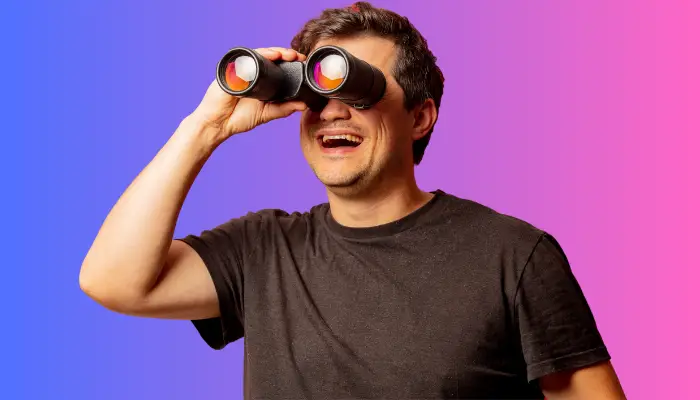This post may contain affiliate links which means I may receive a small commission for purchases made through the links. Learn More
What is eye relief in binoculars? It is actually a very important aspect of binoculars that determines the distance between the eyepiece and the viewer’s eye. Eye relief of more than 15 mm is considered optimal – however, eye relief of 16mm falls in the ideal category.
Most of the time, I have noticed that people don’t give value to eye relief and ignore its importance which end of hurts their buying decision. This factor is very important for those who wear glasses due to weak vision. In this guide, I will into the details of eye relief and give you in-depth information.
Also Read: Can You Transfer the Warranty of Binoculars?
Explanation of Binoculars Eye Relief
As I said earlier that eye relief refers to the distance between the eyepiece lens and the eye of the user. It is an essential factor to consider and making negligence will affect your comfort level and the quality of the image viewed.
It is measured in millimeters and is usually indicated in the binocular specifications. The eye relief distance is essential because it determines how far away the user can hold the binoculars from their eyes and still see the entire field of view.
Importance of Eye Relief
The importance of eye relief lies in the comfort level and quality of the image viewed. If the eye relief distance is too short, the user will have to press their eyes against the eyepiece lens, which can cause discomfort and eye strain.
In case the eye relief distance is too long, the user won’t be able to see the entire field of view, resulting in a cropped or distorted image. While using binos, no one likes to get cropped visuals of the target.
Keep in mind that eye relief is particularly important for people who wear glasses. The ideal eye relief distance for those who wear glasses is around 16 to 17mm.
I highly recommend you always buy binos that come with adjustable eyecups. Binos with adjustable eyecups help users adjust the distance between the eyepiece lens and their eyes to achieve the correct eye relief distance.
Types of Eye Relief
There are two main types of eye relief in binoculars and their names are listed below:
- Long Eye Relief
- Short Eye Relief
Long eye relief binoculars have an eye relief of 15mm or more. Binoculars that come with longer eye relief are more comfortable to use and don’t cause any sort of strain.
There is a misconception out there that long eye relief is only good for those people who have weak eyesight and wear glass. This is not true.
These binoculars are good for both glass wearers and nonglass wearers. They increase the distance and help you see everything clearly without making your eyes tired. You will be able to get a comfortable viewing experience.
On the opposite side, the short eye relief binoculars have an eye relief of less than 10mm. They are designed for people who don’t wear glasses and want compact and lightweight binoculars.
If you ask me my true opinion, I would say that these binoculars with shorter eye relief are useless as they won’t be comfortable to use for an extended duration.
You might be able to get good visuals without glasses, but when you will wear glasses, you won’t be able to use these binos. They will surely cause eye strain if used for extended periods.
How to Measure Eye Relief?
To know what is the eye relief of your specific model of binoculars, you can check the box of binoculars where all the details about eye relief will be mentioned. You won’t need to measure it by yourself.
However, if your binocular is too old, and you don’t have its box, then you’ll need to measure the eye relief to know its exact reading. Rest assured that measuring eye relief is an easy process.
One of the easiest ways to measure eye relief is by using a ruler. I am very much sure you would already have a ruler in your home. If you don’t have one, consider buying one.
- Close your right eye and place the ruler against the left eyepiece lens.
- Look through the left eyepiece lens with your left eye and note the distance between the ruler and your eye.
- You will have to repeat the same process with your right eye by closing your left eye.
- If the reading for both eyes is the same, then note this reading is your binocular’s eye relief.
- In case you get different eye relief readings, then it means you made a mistake. Repeat the process to get the same reading for both eyes.
What is the Best Eye Relief- Long or Short?
Want to know the best size, well, there is no one-size-fits-all answer. The ideal eye relief depends on the individual’s needs, preferences, and use case.
But I give you an estimate that will help you understand the eye relief that you’ll need. In case you have glasses due to weak vision, then the best size will be around 16 to 16mm.
But if you don’t wear glasses, then going with 14 to 15mm binos is also a good call. You won’t regret using 15 mm binoculars no matter if you wear glasses or not.
If you are confused about long and short eye relief, then I recommend you to read the above section which explained the types of eye relief. Long eye relief is always a better option in binos.
Could the eye relief in binoculars be adjusted?
Yes, the eye relief in binoculars can be adjusted. Almost all modern binoculars come with adjustable eye cups or twist-up eyepieces that allow you to customize the eye relief to your liking.
Keep in mind that If the eye relief is too short, glasses can get in the way and impede the user’s field of view. So I highly recommend you buy binoculars that give you the option to adjust the eye relief of your binoculars.
Twist-up eyecups (adjustable) are ideal for glass wearers as they allow the user to adjust the distance between the eyepiece and their glasses. This ensures that the user can see the entire field of view without any obstructions.
Good Eye Relief For Non-Glass Wearers
For non-glass wearers, it is recommended to have an idea to have binos with eye relief of at least 13 to 14mm. However, 15 mm eye relief is also considered optimal.
If you think eye relief is not important for the non-glass wearer, then you’re wrong. It is an important consideration for non-glass wearers to ensure a comfortable viewing experience.
Frequently Asked Questions
Larger eye relief is generally better for binoculars, as it allows users to view the entire field of view without any strain. The ideal eye relief for those who wear glasses is around 16-17mm.
Eye relief is usually measured in millimeters rather than inches. The ideal eye relief for those who wear glasses is around 16-17mm.
“3 eye relief” likely refers to a binocular with an eye relief of 3mm. This would be considered very low and definitely cause discomfort for some users.
Higher eye relief is generally better for binoculars, as it allows users to view everything clearly without any sort of strain.
Yes, using 12mm eye relief with glasses causes eye strain.
The eyepiece is the lens fixed on the front side of the binoculars, while eye relief is the distance between the eyepiece lens and the user’s eye. The eyepiece determines the binocular focus, while eye relief affects the size of the image seen through the binoculars and can also affect the user’s comfort while using the binoculars.

Miqdad is a passionate outdoor adventurer and an expert in optics. He holds degrees in the field and his love for exploring nature up close with binoculars has driven him to research and deepen his knowledge of optics. All the content present on this website is written by Miqdad as he is a proficient writer as well.

